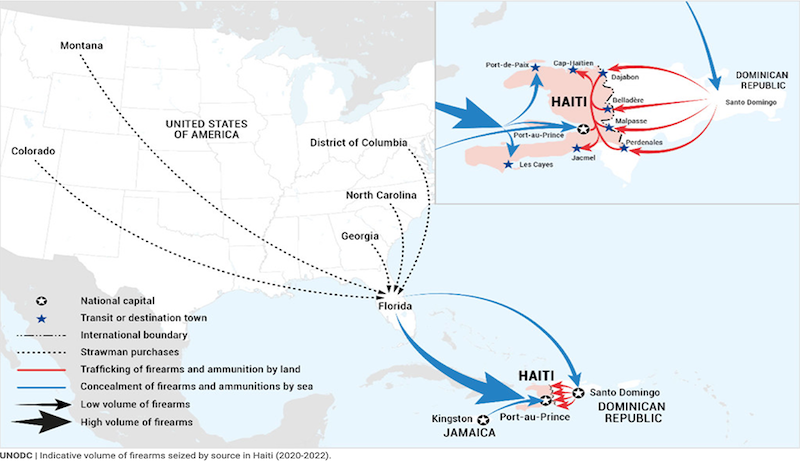Amid Violent Conflict, Mexico’s Sinaloa Cartel Thankful For US Guns – Analysis
By Alexander Miller
Members of the Sinaloa Cartel expressed their appreciation for the availability and abundance of guns in the US in a recent documentary. The flow of illicit firearms from the US to Mexico is well-documented, but it is uncommon for members to share details of their organization’s illicit activities, especially to a film crew. The members’ openness shows a high level of confidence in their cartel’s ability to continue receiving US guns, despite ongoing law enforcement efforts.
This illicit economy and the Sinaloa Cartel’s role in it are widely known. With a long history and reputation of indiscriminate violence, the Sinaloa Cartel is the most powerful group in Mexico’s criminal underworld. And guns are critical to their power. Luckily for Sinaloa, there’s an arsenal next door. Like the Sinaloa members said in the documentary, obtaining and trafficking them is easy, plus there are plenty to go around.
The US manufactured more than 11 million guns in 2020 and more than 13 million in 2021. And the Mexican government estimates that 200,000 are smuggled each year. The exact number of US guns in Mexico is unknown, but a study by the Government Accountability Office found that 70 percent of guns recovered in Mexico between 2014 and 2018 came from the US. It is difficult to quantify the exact number of US guns in Sinaloa’s arsenal, but in the documentary, a member stated they currently have thousands of .50-caliber sniper rifles. This rifle is a favorite among cartels because it fires a bullet roughly the size of a cigar that can penetrate bullet-proof armor and vests. Many view these rifles as ‘weapons of war’ because the US military used them in Iraq and Afghanistan. According to data cited in the documentary, 279 .50 caliber rifles from US gun stores were recovered in Mexico since 2016.
This rifle is representative of the types of guns and ammunition the US provides, and the extent to which cartels use them for violence. Moreover, cartels also exchange US guns for drugs from other criminal groups like the Ex-FARCin Colombia. While Mexico likely has more US guns than any other country, the rest of Latin America and the Caribbean are also flooded with high-caliber US guns, including the .50 caliber Barrett rifle. During a police operation targeting an alliance of armed groups in Caracas, security forces seized an M82 Barrett rifle among an array of assault rifles and ammunition. Non-state armed actors in Venezuela are well-equipped to challenge the state’s monopoly on the use of force because of their access to the US civilian market.
The criminal landscapes in Mexico and Venezuela are prime examples of the costly impact of US gun laws and law enforcement. Violent conflict between security forces and heavily armed non-state actors is the norm, and so are civilian casualties and endangerment, human rights abuses, and poor governance. According to Timothy Sloan, the top official in Mexico from the Bureau of Alcohol, Tobacco, and Firearms (ATF), the main federal agency responsible for enforcing US gun laws, at least 97,000 illegal guns in Mexico were traced back to the US.
Sloan also described a gunfight between state security forces and members of the Cartel Jalisco New Generation, who were trying to assassinate Mexico City’s police chief in June 2020. The gunfight killed two bodyguards and a bystander and wounded the police chief. After the event, US and Mexican law enforcement seized 37 guns, including five .50 caliber rifles, which Sloan said was “the firepower of the height of the war in Iraq and Afghanistan.” Using the serial numbers on the seized guns, they were all traced to 62 buyers in the US, many of whom were already under investigation by the ATF. This case is an ideal but uncommon scenario, where the ATF can use the guns to trace and identify initial buyers. But many consider the ATF to be underfunded, understaffed, and unable to fulfill their job, and the ATF’s absence is a significant reason behind the large number of US guns flowing into Mexico. This case also shows that multiple cartels use the US civilian market for their arsenals and that serial numbers are an integral part of criminal investigations into and court cases against initial buyers, the roots of the illicit supply chain.
Sloan said that he believes most guns coming into Mexico travel across the US-Mexico border because of how easy it is. And the Sinaloa members reiterated this and cited the same reason. Access to the US civilian market is different for every country and region, which makes counter-proliferation a difficult task. For example, Mexico has direct access to guns due to its proximity to US states that have a vast stockpile and lax enforcement of gun laws. Venezuela and the rest of the region transport US guns by sea or air, typically through major ports. The US state Florida is a hub for arms trafficking because law enforcement can’t consistently manage the volume of people and packages going in and out daily and the large Latin American diaspora. Florida law enforcement has seized shipments of guns en route to Haiti, Brazil, Venezuela, and Argentina.
These dynamics only account for the procurement of new US guns into the black market. Unlike drugs, firearms are durable goods that can circulate indefinitely. Ideally, the circulation of illicit guns ends when they are seized and destroyed, but this is not always the case. Corruption and poor arsenal management further fuel black markets with illicit firearms. Moreover, traffickers are tricky and skilled at evading detection by exploiting weaknesses in US gun laws and US law enforcement. One such weakness is the private sale loophole, which allows for the legal sale of guns from unlicensed sellers to individuals without a background check. Another key weakness is straw purchasing, when individuals with a clean background check buy guns to sell or give to others. The Sinaloa member in the documentary said that a kid buys guns and transports them across the border in a car, trailer, or plane, and “passes them on” to the cartel.
One of the more innovative methods is the sale of “ghost guns,” which are privately assembled from purchasable parts that do not have a traceable serial number. US manufacturers were able to produce gun parts without a serial number by only partially completing the parts, often up to 80%. Until April 2022, US law only regulated completed gun parts; hence, a part that is only 80% complete is not subject to regulations.
A new US law, signed in June 2022, targeted several issues underlying arms trafficking like ghost guns and straw purchasing. The new law is a step in the right direction because it highlights the pitfalls of US gun laws, but experts were divided on its ability to change the situation. The divide between skepticism and optimism regarding the law is based on several observations. One such observation, according to Insight Crime, is that it has not been passed as a law yet and is already experiencing resistance in the US Congress and in the courts.
To fill the regional void of comprehensive anti-arms trafficking efforts, the Mexican government filed two lawsuits, the first against six US gun manufacturers and the second against gun dealers in southern US states. The first lawsuit was dismissed and the second is still pending, but experts have largely doubted its chances of success. These lawsuits show that the Mexican government believes the US has failed to stem arms trafficking through law enforcement-based efforts, so a new legal-based approach is overdue. Alejandro Celorio, the lead attorney in both lawsuits, said that they are based on negligence from US gun dealers and manufacturers and data from ATF.
He says that the gun industry has “a perfect business” of causing problems by arming criminals and then selling the guns to state security forces as the solution to the problems.
The data Celorio cites states that 70 to 90 percent of guns used by criminals come from the US and less than 3 percent of the guns found at crime scenes come from security forces. Celorio also emphasized the fact that these guns don’t come from Mexico’s only legal gun store, which doesn’t sell high-powered rifles like the Barrett .50 caliber.
Given the minimal political appetite to discuss issues that don’t relate to China, Russia, North Korea, or Iran, a new and improved approach to countering arms trafficking is highly unlikely. And the minimal appetite seemingly extends to US law enforcement, according to Sloan, who said that the current US ambassador to Mexico doesn’t prioritize arms trafficking.
Today, it is easy for anyone in the US to buy an arsenal and transport it to the warring cartels in Mexico, or to any criminal actor in Latin America and the Caribbean. Until the US government acts productively against arms trafficking, instrumental violence will continue, and peace will remain nonexistent for an overwhelmingly large number of civilians.
This article was published by Geopolitical Monitor.com


